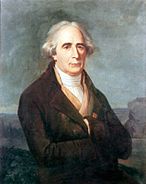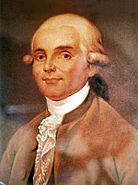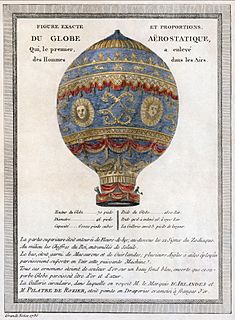Montgolfier brothers facts for kids
Quick facts for kids
The Montgolfier brothers
|
|
|---|---|
|
Joseph-Michel (left) and Jacques-Étienne Montgolfier, late 18th century
|
|
| Born | Joseph-Michel: 26 August 1740, Annonay, Ardèche, France Jacques-Étienne: 6 January 1745, Annonay, Ardèche, France |
| Died | Joseph-Michel: 26 June 1810 (aged 69), Balaruc-les-Bains, France Jacques-Étienne: 2 August 1799 (aged 54), Serrières, France |
| Occupation | Inventors, balloonists, paper manufacturers |
| Known for | Making the first confirmed human flight, in a Montgolfière-style hot air balloon |
The Montgolfier brothers – Joseph-Michel Montgolfier (born August 26, 1740) and Jacques-Étienne Montgolfier (born January 6, 1745) – were amazing inventors from Annonay, France. They were pioneers in aviation and also skilled paper manufacturers. They are most famous for inventing the Montgolfière-style hot air balloon. In 1783, their balloon made the first confirmed flight by a human, carrying Jacques-Étienne. Joseph-Michel also invented a special water pump called the self-acting hydraulic ram in 1796. Jacques-Étienne started the first school for making paper. Together, the brothers also found a way to make transparent paper.
Contents
Early Life of the Montgolfier Brothers
Joseph-Michel and Jacques-Étienne Montgolfier were born into a family that owned a paper manufacturing business. Their parents, Pierre Montgolfier and Anne Duret, had 16 children! Pierre planned for his oldest son, Raymond, to take over the family business.
Joseph-Michel was the 12th child. People described him as a free spirit and a dreamer. He was very creative but not always practical with business matters. Étienne was the 15th child. He was much more organized and business-minded. He went to Paris to study architecture.
In 1772, Raymond suddenly died. Étienne had to return to Annonay to manage the family paper business. Over the next 10 years, Étienne used his talent for new ideas to improve the paper making process. He added the latest techniques from the Netherlands to their family mills.
Hot Air Balloon Experiments (1782–1784)
First Ideas and Experiments (1782)
Joseph was the first of the brothers to become interested in flying. As early as 1775, he built parachutes and even jumped from the family house once! He first thought about building flying machines when he saw laundry drying over a fire. The cloth would billow upwards, forming pockets of air.
Joseph did his first real experiments in November 1782 in Avignon. He later said he was watching a fire one evening. He was thinking about a big military problem: attacking the fortress of Gibraltar, which was impossible to attack from land or sea. Joseph wondered if troops could attack from the air using the same force that lifted embers from the fire. He thought the smoke itself was the part that made things float. He called this special gas "Montgolfier Gas."
Joseph then built a small box, about 1 meter by 1 meter by 1.3 meters (3 feet by 3 feet by 4 feet). He made it from thin wood and covered it with light taffeta cloth. He lit some crumpled paper under the box. The box quickly lifted off its stand and hit the ceiling!
Joseph quickly told his brother about his discovery. He wrote, "Get a supply of taffeta and rope, quickly, and you will see one of the most astonishing sights in the world." The brothers then built a similar device, but three times larger. On December 14, 1782, they did their very first test flight. They used wool and hay for fuel. The lifting force was so strong that they lost control of their craft. The device floated almost two kilometers (about 1.2 miles) away. It was destroyed by curious people after it landed.
Public Demonstrations (Summer 1783)
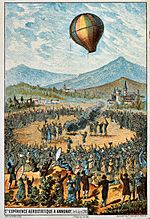
To show their invention to the public and claim it as their own, the brothers built a large, globe-shaped balloon. They made it from sackcloth with three thin layers of paper inside. The balloon could hold almost 790 cubic meters (28,000 cubic feet) of air. It weighed 225 kilograms (500 pounds). It was made of four pieces held together by 1,800 buttons. A net of ropes covered the outside for extra strength.
On June 4, 1783, they flew the balloon in Annonay. Many important people from the local government watched. The balloon flew for 10 minutes, covering 2 kilometers (1.2 miles). It reached an estimated height of 1,600 to 2,000 meters (5,200 to 6,600 feet). News of their success quickly reached Paris. Étienne went to the capital to do more demonstrations and make sure everyone knew the brothers had invented flight. Joseph stayed home because he was shy and less formal.
In Paris, Étienne worked with Jean-Baptiste Réveillon, who made wallpaper. They built a balloon that could hold 37,500 cubic feet of air. It was made of taffeta coated with a special varnish to make it fireproof. The balloon was sky blue and decorated with golden designs, signs of the zodiac, and suns.
The next test was on September 11. People were worried about how flying high in the sky might affect living creatures. The king suggested sending two criminals, but the inventors decided to send animals first.
On September 19, 1783, the Aérostat Réveillon flew with the first living beings in a basket attached to the balloon. These passengers were a sheep named Montauciel ("Climb-to-the-sky"), a duck, and a rooster. The sheep was chosen because its body was thought to be similar to a human's. The duck was expected to be fine, and it helped show if any effects were from the flight itself. The rooster was included because it was a bird that didn't fly at high altitudes. This demonstration happened at the royal palace in Versailles. King Louis XVI of France and Queen Marie Antoinette watched with a large crowd. The flight lasted about eight minutes, covered two miles (3 km), and reached a height of about 1,500 feet. The balloon landed safely.
First Piloted Human Flight (Autumn 1783)
Since the animals survived, the king allowed humans to fly. Étienne again worked with Réveillon to build a larger balloon for human flights. This balloon could hold 60,000 cubic feet of air. It was about 23 meters (75 feet) tall and 15 meters (50 feet) wide. Réveillon added beautiful gold decorations on a deep blue background. These included fleur-de-lis, zodiac signs, and suns with King Louis XVI's face. Red and blue fabric and golden eagles decorated the bottom of the balloon.
Étienne Montgolfier was the first human to lift off the Earth in a balloon. He made a test flight while the balloon was tied down. This happened in the yard of Réveillon's workshop, probably on October 15, 1783. Later that same day, a scientist named Pilâtre de Rozier became the second person to go up in the air. He reached a height of 80 feet, which was the length of the rope holding the balloon.
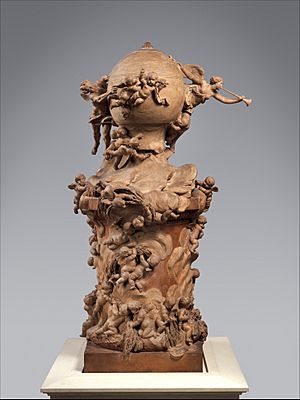
On November 21, 1783, the first free flight by humans took place. The passengers were Pilâtre de Rozier and an army officer, the marquis d'Arlandes. The flight started from the grounds of the Château de la Muette in Paris. They flew about 3,000 feet above Paris for nine kilometers. After 25 minutes, the balloon landed safely outside the city. They still had enough fuel to fly much farther. However, burning embers from the fire were scorching the balloon fabric. Pilâtre even took off his coat to put out a small fire!
These early flights caused a huge sensation. Many pictures were made to remember the events. People designed chairs with balloon shapes on the backs. Clocks were made to look like balloons. You could even buy dishes decorated with pictures of balloons.
In December 1783, King Louis XVI of France honored their father, Pierre Montgolfier. He was given a special title, and the family name became de Montgolfier.
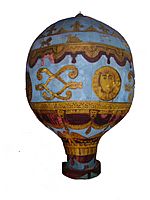
Other Early Balloons and Claims
Some people believe that the hot air balloon was invented about 74 years earlier by a Brazilian/Portuguese priest named Bartolomeu de Gusmão. However, most aviation historians do not agree with this claim.
On December 1, 1783, a few months after the Montgolfiers' first flight, Jacques Charles rose to a height of about 3 kilometers near Paris. He used a balloon filled with hydrogen gas, which he had developed.
In early 1784, a hot air balloon called the Flesselles balloon had a rough landing with its passengers.
In June 1784, a hot air balloon named the Gustave (in honor of King Gustav III of Sweden) carried the first female aeronaut, Élisabeth Thible.
Other Montgolfier Inventions
Both brothers invented a way to make transparent paper that looked like vellum. They used a technique similar to English papermakers.
In 1796, Joseph Michel Montgolfier invented the first self-acting hydraulic ram. This was a water pump that could raise water for his paper mill. In 1797, Joseph's friend Matthew Boulton helped him get a British patent for his invention.
Legacy of the Montgolfier Brothers
Both brothers were members of a special group called Les Neuf Soeurs lodge in Paris.
In 1799, Étienne de Montgolfier died while traveling. His son-in-law, Barthélémy Barou de la Lombardière de Canson, took over the company. The company became "Montgolfier et Canson" in 1801, and then "Canson-Montgolfier" in 1807. In 1810, Joseph-Michel died.
The Montgolfier Company in Annonay still exists today under the name Canson. It makes high-quality art papers, drawing papers for schools, and special papers for digital art and photography. Their products are sold in 150 countries around the world.
In 1983, the Montgolfier brothers were honored by being added to the International Air & Space Hall of Fame at the San Diego Air & Space Museum.
See also
 In Spanish: Hermanos Montgolfier para niños
In Spanish: Hermanos Montgolfier para niños


